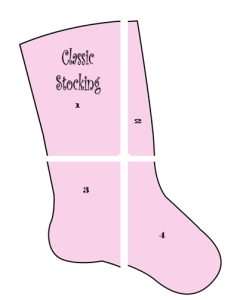 What an absolutely and utterly amazing day. The people, the majesty, the TV and Web coverage, the history, the swearing in, the speech, the man. Tears, laughter, cheers, gratitude, hope, and pride are among my personal experiences of this day.
What an absolutely and utterly amazing day. The people, the majesty, the TV and Web coverage, the history, the swearing in, the speech, the man. Tears, laughter, cheers, gratitude, hope, and pride are among my personal experiences of this day.
The only other inauguration I remember was Reagan’s. I was in 8th grade at St. Agnes School, and they actually wheeled in a TV so that we could watch not only Reagan’s inauguration, but the release of the Iranian hostages. As a lifelong Democrat, you’d think I would have memories of Clinton, but no. I don’t even remember where I was or what I did just four years ago, when Bush claimed his second term.
So in honor of this great day, I offer the Inauguration Stocking, a creative way to preserve the moment and create an heirloom gift for your favorite Obama supporter.
Steps Involved in Making Your Own Inauguration Stocking
You will create this stocking by finding a photo you like and using an iron-on transfer to place the image on a suitable cotton-based fabric. Iron-ons take some work to do well, but they’re easier than you might think. I will do my best to give you step-by-step instructions, including a materials list.
Materials List
- An inkjet printer compatible for use with iron-on transfers
- Regular paper for printing previews of your design
- Iron-on transfers, which you can purchase either at the fabric/crafts store or at most office supply stores
- Iron – on the cotton setting without steam
- Fabric or pre-made stocking to decorate – it should be at leas5 50 percent cotton (I generally use muslin or old bedsheets for my photo transfer stockings)
- An swatch of the same material to test the image-fastness
Directions
- The first thing you need to do is find the picture you want to use. Lord knows that by the end of the day, you will have loads to choose from. MSNBC always has a great photo collage of these events, as does Huffington Post.
- Print a preview of your design on regular paper. It should look exactly the way you want it to appear on the stocking. If you’d like words on the stocking, make sure to include those with the image. Adjust and print previews on regular paper until you are satisfied with the appearance of your design.
- NOTE: You will be using a MIRROR IMAGE to iron onto your fabric/stocking, so the image must be flipped when you print it. Follow your printer directions to flip or “reverse” the image. If you’re not sure whether your image needs reversing, look at it in the mirror. If it looks backwards, you should flip the design. (This is an especially important test if your iron-on includes text.)
- Print your design onto iron-on transfer paper. You’ll want to print two if you plan to do a test version first.
- Carefully cut out your design, leaving about a one-quarter-inch border.
- Set your iron to the “cotton” or hottest setting, and turn off the steam.
- Test your design by ironing it onto a sample piece of material.
- As an alternative to an ironing board, a low, flat surface like a workbench might allow you to press harder when you iron.
- Following the directions for how long to apply pressure, iron your design onto your fabric or stocking.
- Allow the design to cool and peel the paper backing from the iron-on transfer.
NOTE: You will likely want to clip and save the instructions for cleaning the material with your iron-on transfer.
Next Steps
If you have used a pre-made stocking, you can choose to embellish it with jewels, baubles, or fabric paint. If you are making your own stocking from scratch, you’ll next need to choose a pattern for the stocking that best suits your image. Then, you will follow Laura’s special abridged stocking creation instructions:
Cut.
Sew.
Decorate.
Hang.
Stuff.
Enjoy.



 Regardless of where or how you acquire a Christmas stocking, if it’s meant to be filled by Santa for a specific person, you’ll probably want to put that person’s name on the stocking. (All of the stockings available for purchase from By the Chimney With Care can be personalized at no extra cost.)
Regardless of where or how you acquire a Christmas stocking, if it’s meant to be filled by Santa for a specific person, you’ll probably want to put that person’s name on the stocking. (All of the stockings available for purchase from By the Chimney With Care can be personalized at no extra cost.)
 before you trace them. Cut out the letters.
before you trace them. Cut out the letters.
 or knit fabric. It may be pretty difficult to pull a needle with yarn through most cotton prints and/or the several layers you will likely need to stitch through with a stocking. Make sure your have a sharp needle with an eye large enough to accommodate your yarn or floss. As instructed above, make sure you’ve figure out how much room your name will take, and where you want to position it on the stocking. Make sure your yarn/floss is in a contrasting color that will be easily read against the stocking fabric. Cut the yarn/floss no longer than 1 yard (or it’s likely to get tangled). Use about 1/4 -inch stitches to spell the name. If you run out of yarn/floss, tie a knot on the inside/reverse of the fabric. Cut a new piece of yarn/floss, and continue until you’ve finished.
or knit fabric. It may be pretty difficult to pull a needle with yarn through most cotton prints and/or the several layers you will likely need to stitch through with a stocking. Make sure your have a sharp needle with an eye large enough to accommodate your yarn or floss. As instructed above, make sure you’ve figure out how much room your name will take, and where you want to position it on the stocking. Make sure your yarn/floss is in a contrasting color that will be easily read against the stocking fabric. Cut the yarn/floss no longer than 1 yard (or it’s likely to get tangled). Use about 1/4 -inch stitches to spell the name. If you run out of yarn/floss, tie a knot on the inside/reverse of the fabric. Cut a new piece of yarn/floss, and continue until you’ve finished.


 stocking is
stocking is  Some folks may choose not to spell out the whole name, opting instead to use simply a single initial. Of course, this might be challenging for those alliterative families like Connie, Craig, Cara, Caitlin, Connor, and Cameron Coors.
Some folks may choose not to spell out the whole name, opting instead to use simply a single initial. Of course, this might be challenging for those alliterative families like Connie, Craig, Cara, Caitlin, Connor, and Cameron Coors.










